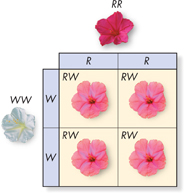11.3 Other Patterns of Inheritance
 What are some exceptions to Mendel's principles?
What are some exceptions to Mendel's principles? Does the environment have a role in how genes determine traits?
Does the environment have a role in how genes determine traits?
incomplete dominance • codominance • multiple allele • polygenic trait
Outline Make an outline using the green and blue headings. As you read, write bulleted notes below each heading to summarize its topic.
THINK ABOUT IT Mendel's principles offer a tidy set of rules with which to predict various patterns of inheritance. Unfortunately, biology is not a tidy science. There are exceptions to every rule, and exceptions to the exceptions. What happens if one allele is not completely dominant over another? What if a gene has several alleles?
Beyond Dominant and Recessive Alleles
 What are some exceptions to Mendel's principles?
What are some exceptions to Mendel's principles?
Despite the importance of Mendel's work, there are important exceptions to most of his principles. For example, not all genes show simple patterns of inheritance. In most organisms, genetics is more complicated, because the majority of genes have more than two alleles. Also, many important traits are controlled by more than one gene. Understanding these exceptions allows geneticists to predict the ways in which more complex traits are inherited.
Incomplete Dominance A cross between two four o'clock (Mirabilis jalapa) plants shows a common exception to Mendel's principles.  Some alleles are neither dominant nor recessive. As shown in Figure 11–12, the F1 generation produced by a cross between red-flowered (RR) and white-flowered (WW) Mirabilis plants consists of pink-colored flowers (RW). Which allele is dominant in this case? Neither one. Cases in which one allele is not completely dominant over another are called incomplete dominance. In incomplete dominance, the heterozygous phenotype lies somewhere between the two homozygous phenotypes.
Some alleles are neither dominant nor recessive. As shown in Figure 11–12, the F1 generation produced by a cross between red-flowered (RR) and white-flowered (WW) Mirabilis plants consists of pink-colored flowers (RW). Which allele is dominant in this case? Neither one. Cases in which one allele is not completely dominant over another are called incomplete dominance. In incomplete dominance, the heterozygous phenotype lies somewhere between the two homozygous phenotypes.
Codominance A similar situation arises from codominance, in which the phenotypes produced by both alleles are clearly expressed. For example, in certain varieties of chicken, the allele for black feathers is codominant with the allele for white feathers. Heterozygous chickens have a color described as “erminette,” speckled with black and white feathers. Unlike the blending of red and white colors in heterozygous four o'clocks, black and white colors appear separately in chickens. Many human genes, including one for a protein that controls cholesterol levels in the blood, show codominance, too. People with the heterozygous form of this gene produce two different forms of the protein, each with a different effect on cholesterol levels.

FIGURE 11–12 Incomplete Dominance In four o'clock plants, the alleles for red and white flowers show incomplete dominance. Heterozygous (RW) plants have pink flowers—a mix of red and white coloring.

Table of Contents
- Formulas and Equations
- Applying Formulas and Equations
- Mean, Median, and Mode
- Estimation
- Using Measurements in Calculations
- Effects of Measurement Errors
- Accuracy
- Precision
- Comparing Accuracy and Precision
- Significant Figures
- Calculating With Significant Figures
- Scientific Notation
- Calculating With Scientific Notation
- Dimensional Analysis
- Applying Dimensional Analysis




